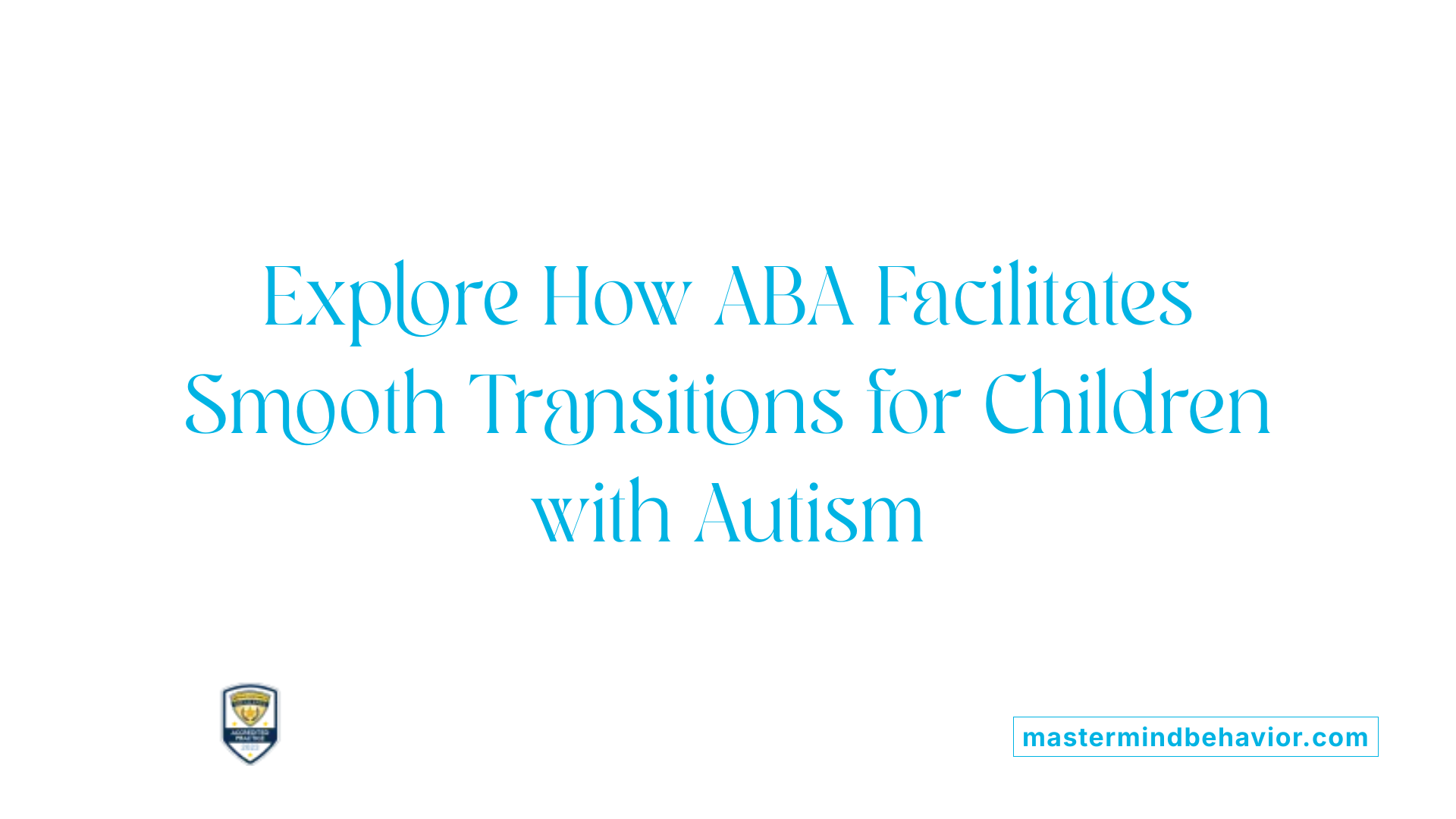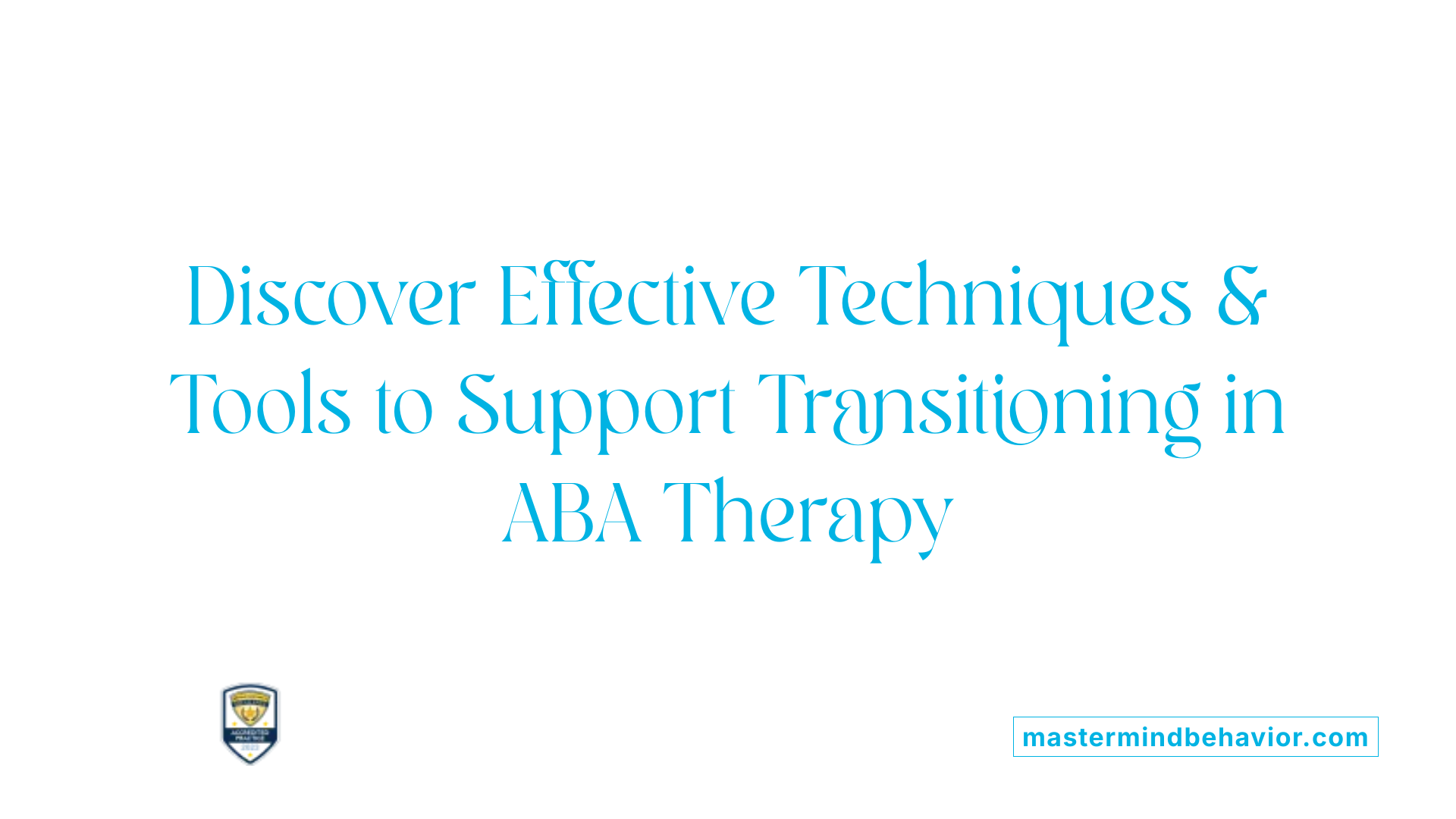How ABA Therapy Improves Coping During Times Of Transition

Understanding ABA Therapy and Its Impact on Transitions
Applied Behavior Analysis (ABA) therapy is a well-established, scientific approach that helps individuals with autism spectrum disorder (ASD) and other developmental challenges manage behaviors and acquire vital skills. Particularly during times of transition—a period often marked by uncertainty and stress—ABA therapy offers targeted strategies to help children adapt successfully, promoting confidence and reducing anxiety. This article explores how ABA therapy supports individuals in coping with change and highlights its techniques, providers, and benefits during such critical periods.
What is ABA Therapy and How Does It Support Behavioral Development?
What is applied behavior analysis (ABA) therapy?
Applied behavior analysis (ABA) therapy is a scientific method focused on understanding and changing behaviors. It is widely recognized as an effective treatment for individuals with autism spectrum disorder (ASD) and other developmental challenges. ABA therapy uses carefully designed techniques to increase positive behaviors like communication, social interactions, and daily living skills, while reducing unwanted or harmful behaviors.
How does ABA therapy work to modify behavior?
ABA therapy employs individualized treatment plans developed after thorough behavioral assessments by Board-Certified Behavior Analysts (BCBAs). These plans break down complex skills into manageable steps and use strategies such as positive reinforcement, direct instruction, and natural environment training to promote skill acquisition. Visual supports, social stories, and structured routines are commonly used tools to create predictability and reduce anxiety.
Where is ABA therapy provided?
ABA therapy can be delivered in various settings tailored to individual needs, including homes, schools, clinics, and community environments. Caregiver involvement is an important component; families receive guidance on implementing strategies consistently across settings to maximize effectiveness.
What research supports ABA therapy?
ABA is backed by hundreds of peer-reviewed studies and is endorsed by respected organizations as the most effective treatment for ASD. Early and intensive intervention, ideally starting before age six, has shown significant improvements in communication, social skills, and independence.
Through this evidence-based and personalized approach, ABA therapy helps children develop essential life skills while improving overall quality of life and social integration.
How ABA Therapy Helps Individuals with Autism Navigate Transitions

How does ABA therapy help individuals with autism?
ABA therapy supports individuals with autism by teaching new skills and improving crucial areas such as communication, social interactions, and daily living activities. It uses evidence-based strategies like positive reinforcement and structured instruction, tailored specifically to each child’s strengths and needs, ensuring therapy is effective whether at home, school, or community environments.
Role of ABA in improving communication and social skills
ABA enhances communication through targeted techniques including the use of pictures, games, and direct instruction, making it easier for children to express themselves. Social skills develop through group learning scenarios and natural environment training, which encourage interaction and friendship-building.
Building coping skills during change
For children who struggle with self-regulation, ABA builds coping strategies that help manage emotions such as anger and frustration. This prepares them to handle transitions with greater control and confidence.
Use of routines, visual schedules, and countdowns to reduce anxiety
Creating predictable routines is central to ABA's approach. Visual schedules, countdowns, and verbal cues establish clear expectations, which reduce anxiety by preparing the child for what is coming next. For example, visual charts at home or warning signals at school signal upcoming changes.
Breaking transitions into manageable steps
ABA breaks down transition processes into smaller, manageable tasks. This gradual approach helps children experience success incrementally, building confidence and reducing overwhelm during changes.
Teaching flexibility and resilience through adaptation to changes
ABA encourages flexibility by introducing opportunities to adapt when plans change. This strengthens resilience, enabling children to better handle unpredictability.
Use of social stories and visual supports
Tools like social stories help children understand upcoming changes by depicting transitions in simple, relatable narratives. Visual supports complement these stories to further ease anxiety about new situations.
ABA’s personalized and structured methods not only ease transitions but also empower children with autism to navigate daily life more independently and confidently.
Techniques and Tools ABA Employs to Ease Transitions

What are the common techniques used in ABA therapy?
ABA therapy uses a variety of structured methods to help children navigate transitions smoothly. Discrete trial training (DTT) offers focused skill instruction through repeated practice, with immediate positive reinforcement to motivate learning. Natural environment training (NET) incorporates teaching moments into everyday activities to promote skills that generalize beyond therapy sessions.
Positive reinforcement to associate change with positive experiences
A cornerstone of ABA is positive reinforcement, where children receive praise or rewards after successful transitions. This approach helps them link change with positive outcomes, reducing anxiety and encouraging confidence.
Visual supports like charts and schedules at home and school
Visual tools are highly effective in creating predictability. Visual schedules, charts for routines, and countdown timers help children anticipate what comes next, making transitions less stressful both at home and in school settings.
Using warning signals and 'first/then' language
ABA therapists use strategies like warning signals before activity changes and 'first/then' statements to clarify expectations. For example, "First finish your snack, then play outside" guides children step-by-step, making transitions clearer and easier to manage.
Breaking complex transitions into smaller steps
Large transitions are broken down into manageable parts. This gradual approach builds success and confidence, allowing children to adjust with less overwhelm.
Functional communication training and behavior chaining
Functional Communication Training (FCT) equips children with alternative ways to express needs or feelings, helping reduce frustration during changes. Behavior chaining breaks complex sequences into smaller, teachable units, supporting mastery of multi-step transitions.
Together, these ABA techniques and tools create a supportive framework that promotes smoother transitions, reduces stress, and fosters independence for children with autism.
Who Provides ABA Therapy and How is it Tailored During Transitions?

Roles of Board-Certified Behavior Analysts (BCBAs) and Other Professionals
ABA therapy services are primarily delivered by a team of trained professionals, including board-certified behavior analysts (BCBAs), Registered Behavior Technicians (RBTs), and therapists who specialize in autism treatment. BCBAs lead the process, conducting detailed assessments of each child’s behavior and environment. They design individualized treatment plans with specific goals to address the child’s unique needs.
Individualized Assessment and Treatment Planning
Tailoring ABA therapy for transitions involves breaking down challenging changes into smaller, manageable steps. BCBAs customize interventions to create routines, visual supports, and strategies that fit each child's preferences and circumstances. This personalized approach helps reduce anxiety and build confidence during transitions.
Caregiver Involvement and Training for Consistency
Caregivers play a crucial role in the therapy process. BCBAs train family members to implement strategies consistently at home and in the community. This collaboration helps maintain predictability and reinforces positive behaviors, making transitions smoother and more effective.
Coordination with Schools and Community
ABA professionals often coordinate with schools and community programs to ensure a consistent approach across environments. Tools like visual schedules and warning signals are shared and practiced in various settings, promoting seamless adaptation for the child.
Customization of Therapy to Address Transitional Challenges
The therapy plan adapts as needs change, incorporating supports such as social stories, countdown timers, and first/then language. These elements help children anticipate change, manage stress, and develop resilience, all critical for successful transitions.
Together, this comprehensive and collaborative structure makes ABA therapy highly effective at preparing children for change while supporting their overall development and well-being.
Long-Term Benefits of ABA Therapy in Developing Coping and Life Skills

How does ABA therapy contribute to the development of self-regulation and emotional expression?
ABA therapy equips children with coping skills and strategies that help them manage self-regulation. By teaching children to recognize and express their emotions constructively, ABA supports them in handling feelings such as anger and frustration effectively. These skills are essential for emotional well-being and social interactions.
In what ways does ABA prepare children for school and adulthood?
Through simulation learning and foundational skill-building, ABA facilitates successful transitions into school environments. It helps children acquire necessary behaviors and social cues, easing their adaptation to academic settings. Additionally, ABA prepares children for adulthood by promoting behavioral management skills and social understanding crucial for independent living.
How does ABA enhance independence and daily living skills?
ABA therapy focuses on developing essential life skills like personal hygiene, grooming, and the ability to perform daily tasks that children with autism often find challenging. These skills increase independence and contribute to improved quality of life.
What role does ABA therapy play in building resilience and flexibility over time?
ABA fosters flexibility by teaching adaptation to changes in plans and routines. Utilizing tools such as visual schedules, social stories, and breaking transitions into manageable steps, ABA builds resilience gradually, reducing anxiety and encouraging confidence during change.
How does ABA improve social skills and peer interactions?
ABA enhances social skills using group learning, natural environment training, and positive reinforcement. These strategies support children in understanding social cues, facilitating friendships, and improving overall social integration.
| Benefit Area | ABA Therapy Approach | Long-Term Impact |
|---|---|---|
| Self-regulation & Emotional Expression | Teaches coping strategies and emotion management | Better emotional control and constructive expression |
| Preparation for School & Adulthood | Simulation learning and behavior skill development | Smoother school transitions and adult independence |
| Independence & Daily Living | Focus on hygiene, grooming, and daily task mastery | Increased autonomy and life quality |
| Resilience & Flexibility | Use of visual aids and stepwise transitions | Reduced anxiety and enhanced adaptability |
| Social Skills & Peer Interaction | Group learning and social skills training | Improved friendships and social competence |
Supporting Successful Change Through ABA Therapy
ABA therapy offers a scientifically grounded, individualized approach that uniquely equips children with autism to manage the challenges of transitions. By establishing predictable routines, teaching flexibility, and reinforcing positive behaviors, ABA reduces anxiety and builds confidence during periods of change. Delivered by trained professionals who partner closely with families and communities, this therapy not only eases immediate transitions but also fosters long-term coping skills, independence, and social integration. As research continues to validate its effectiveness, ABA remains a cornerstone intervention helping individuals with autism thrive through life’s many changes.
References
- How ABA Therapy Prepares Children for Change
- The Benefits of ABA Therapy
- 6 Benefits of ABA Therapy for Children with Autism
- Applied Behavior Analysis (ABA)
- Applied Behavior Analysis (ABA)
- Applied Behavior Analysis (ABA) for Children With Autism
- Applied Behavior Analysis
- ABA Therapy Examples, Definition & Techniques
Recent articles

Finding Support: Financial Aid And Insurance Advocacy For ABA Therapy
Navigating Financial and Insurance Support for ABA Therapy

The Importance Of Reinforcement Diversity In ABA Programs
Enhancing ABA Therapy Through Varied Reinforcement Approaches

How ABA Therapy Encourages Self-Expression Through Communication
Unlocking Voices: The Role of ABA Therapy in Enhancing Communication for Autism

How ABA Therapy Reduces Inflexible Behavior Patterns
Unlocking Flexibility: The Transformative Impact of ABA Therapy on Autism Behaviors

How ABA Therapy Improves Tolerance To Sensory Experiences
Unlocking Comfort: The Role of ABA Therapy in Sensory Integration for Autism

What Makes In-Home ABA Therapy Different From Clinic-Based ABA
Exploring the Distinctive Features of In-Home and Clinic-Based ABA Therapy



